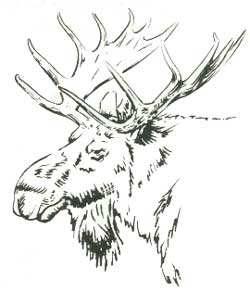
|
Geological Survey Bulletin 1291
The Geologic Story of the Uinta Mountains |
JUST A FEW WORDS ABOUT THE ANIMALS

ANIMALS furred and feathered are so much a part of the Uinta Mountain scene that I would be remiss not to mention them. The casual visitor—one who crosses the mountains in a high-powered automobile or who stops briefly at Dinosaur National Monument—may see a few rodents, a few birds, or possibly even a badger or a mule deer, but probably not much else. But anyone who spends a few hours or a few days away from the highway will be abundantly rewarded.
More than a quarter of a million acres of the High Uintas in the Wasatch and Ashley National Forests has been protected for many years as a primitive area and, under the Wilderness Act of 1964, has been reserved for study as a possible future part of the National Wilderness System. Aside from the primitive area, many additional thousands of acres are in fact wilderness. Game in these areas roams free, unmolested by the encroachments of civilization.
The largest wild animal in the Uinta Mountains is the moose, which ranges mostly on the north slope but occasionally strays over the top into the Duchesne and Provo drainages. His smaller but still-large cousin, the American elk or wapiti, is more widespread, ranging the mountains from end to end and slope to slope. A sizable herd, for example, summers on Cold Spring Mountain. Another ungulate, the mule deer, is very abundant—the big-game animal most likely to be seen. Mule deer prefer open brushy country along the mountain flanks. I have even seen them along the high road to Harpers Corner in Dinosaur National Monument.
Bighorn sheep once were plentiful in the high country and in the canyons as well (hence the name Sheep Creek Canyon). Powell mentioned seeing them in Echo Park. A small herd is sometimes seen by boaters in Lodore Canyon. Elsewhere, they are rare.
The pronghorn antelope, shy but inquisitive, favors the arid flats and benches at the flanks of the range. Pronghorns were common in the Flaming Gorge area 15 years ago, when I first was there. Perhaps they still are. They even flourished on Cold Spring Mountain at altitudes above 8,000 feet, where I once saw an angry doe chasing a coyote.
Mustangs, or wild horses, used to haunt the Flaming Gorge area also, particularly the wide-open country north of Clay Basin. I saw them often at Dutch John Flat before the dam was built. Domestic horses turned loose on the range, of course, are easily mistaken for mustangs, unless they wear bells.
Of the predators, cougars were fairly common in the Eastern Uintas when I was working there, although they were seldom seen. And the experienced camper took precautions to protect his gear from marauding black bears. Coyotes seem to be holding their own, despite the determined onslaughts of well-intentioned exterminators. Many local stockmen recognize their value in helping stem the rodent population, which competes with livestock for food. A "save the coyotes" campaign was mounted a few years ago by alert ranchers.
Smaller animals are on the scene everywhere, and a sharp eye isn't needed to see them, although it helps. Bobcats, badgers, skunks, porcupines, beavers, muskrats, marmots, jack rabbits, cottontails, pikas, golden-mantled ground squirrels, tree squirrels, and chipmunks all are ubiquitous. I used to see an occasional fox, fisher, and weasel.
Whiptail lizards are abundant at lower altitudes, where they often are seen sunning themselves on the warm rocks. Snakes are uncommon. Gopher snakes—formidable of mien, but harmless—are sometimes seen in the dry foothills. Garter snakes and graceful little green snakes thrive in the montane zone. In 6 or 8 years I saw only three rattlesnakes—two near Flaming Gorge and one in Browns Park—all little fellows 12-14 inches long, but each a mature adult fully arrayed with rattles. Small rattlesnakes of this type belong to a dwarf subspecies of the Western rattlesnake, Crotalus viridis. Not being adapted to the rigors of the alpine climate, they favor the lower country in the basins and along the mountain flanks.
Birds, of course, are plentiful, and a good watcher could compile a long list. The more notable kinds include the golden and the bald eagle, the turkey vulture, several species of hawks and falcons, the great horned owl, other smaller owls, the nighthawk, many water birds and waders (including the Canada goose and the great blue heron), the pine grouse and sage hen, the crow, raven, and magpie, the black bird, cliff swallow, junco, bluebird, pinyon jay, and canyon wren, and the favorite of campers, Clarks nutcracker.

| <<< Previous | <<< Contents >>> | Next >>> |
bul/1291/sec6.htm
Last Updated: 18-Jan-2007